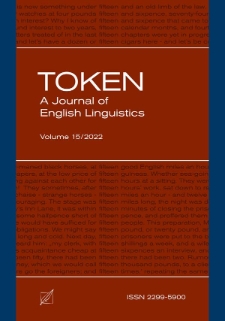Digital Library of the Jan Kochanowski University contains 13 273 digital objects
Object
Title: Kids in the House : How the U.S. House of Representatives addresses youngsters
Creator:
Group publication title:
Contributor:
Newman, John G. Ed. ; Dossena, Marina. Ed. ; Shvanyukova, Polina. Ed. ; Bianchi, Francesca. Guest ed. ; Bruti, Silvia. Guest ed. ; Cappelli, Gloria. Guest ed. Manca, Elena. Guest ed.
Abstract:
Educational websites for children are becoming more and more popular as sophisticated sources of specialized content dissemination. Kids in the House, the website for children created and run by the U.S. House of Representatives, is an interesting example as it is distributed in four different versions targeting preschoolers, grade schoolers, middle schoolers and high schoolers. This contribution aims to analyze quantitatively, qualitatively and comparatively some of the most recurring linguistic features that characterize the four website versions, by concentrating on verbal, and occasionally nonverbal, popularizing strategies. The analysis reveals that there are marked differences among the website versions both in terms of lexical complexity and discourse. Also, verbal and nonverbal popularizing devices seem to closely reflect the needs and tastes of the target audiences.
Table of contents:
Spis treści Francesca Bianchi, Silvia Bruti, Gloria C appelli and Elena Manca, Introduction 5 Elena Manca and Cinzia Spinzi, A cross-cultural study of the popularization of environmental issues for a young audience in digital spaces 19 Silvia Bruti, Ecology for children: Examples from popularizing texts in English and Italian 47 Katia Peruzzo, Empowering children: The UN Convention on the Rights of the Child and its English and Italian child-friendly versions 71 Gianmarco Vignozzi, Kids in the House: How the U.S. House of R epresentatives addresses youngsters 97 Silvia Cacchiani, What is Copyright? Communicating specialized knowledge on CBBC 125 Olga Denti and Giuliana Diani, “Hello, my name is Coronavirus”: Popularizing COVID-19 for children and teenagers 151 Jekaterina Nikitina, Popularizing the Covid-19 pandemic to young children online: A case study 181 Silvia Masi, Disseminating knowledge through TED Talks for children 211 Francesca Bianchi and Elena Manca, Rewriting novels for a young audience: A corpus-assisted comparison between two versions of The Da Vinci Code by Dan Brown 239 Judith Turnbull, Popularizing diversity for children in videos on YouTube 259 Gloria Cappelli, Linguistics for children: The intermodal presentation of English grammar metalanguage in materials for young learners 287 Maria Elisa Fina, Popularizing art for children at the MoMA: A multimodal analysis of the audio-delivered pictorial descriptions 319 Annalisa Sezzi, An intergalactic journey to the popularization of modern art in museum-based websites for children 343
Place of publishing:
Physical description:
Additional notes:
Special issue on popularisation, dissemination and rewriting for young audiences
ISSN:
Publisher:
Jan Kochanowski University Press
Date issued:
Identifier:
oai:bibliotekacyfrowa.ujk.edu.pl:12854 doi:10.25951/9747
Language:
Is part of:
Token : A Journal of English Linguistics
Type:
Access rights:
Format:
Object collections:
- JKU Digital Library > University Publishing > Serial publications > "Token : A Journal of English Linguistics"
Last modified:
Apr 4, 2025
In our library since:
Apr 4, 2025
Number of object content hits:
83
All available object's versions:
https://bibliotekacyfrowa.ujk.edu.pl/publication/9747
Show description in RDF format:
Show description in OAI-PMH format:
| Edition name | Date |
|---|---|
| Gianmarco Vignozzi, Kids in the House: How the U.S. House of Representatives addresses youngsters | Apr 4, 2025 |
Objects Similar
Bruti, Silvia Vignozzi, Gianmarco Newman, John G. Ed. Dossena, Marina. Ed. Ranzato, Irene. Guest ed. Valleriani, Luca. Guest ed.

